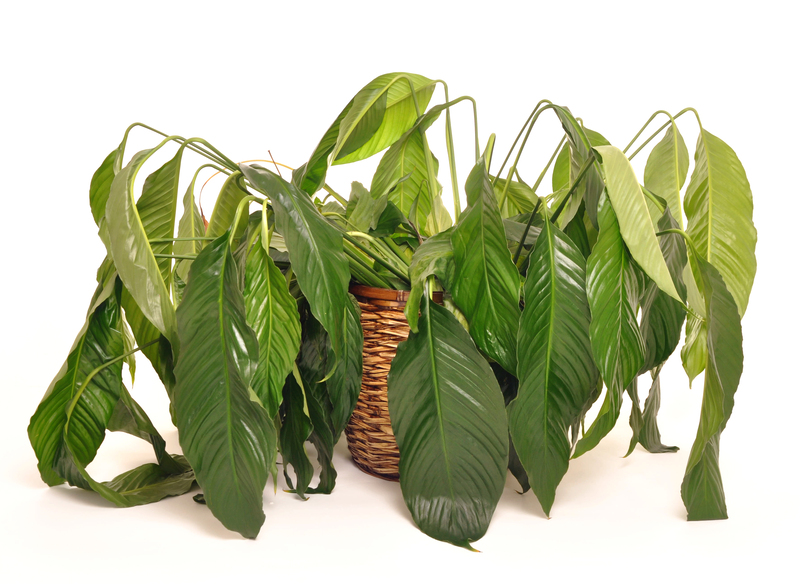Expert Methods for Hedge Trimming Designs
Posted on 16/06/2025
Expert Methods for Hedge Trimming Designs
If you're passionate about nurturing a sophisticated garden, hedge trimming designs are the secret to achieving a mesmerizing landscape. From creating pristine lines of symmetry to quirky animal topiaries, the art of hedge shaping allows gardeners to transform ordinary greenery into striking pieces of living art. In this comprehensive guide, we'll unveil expert methods for hedge trimming designs, provide actionable tips, and share the secrets behind professional techniques. Whether you're an amateur gardener or seeking advanced styles, this is the ultimate resource to elevate your garden's appeal.

The Importance of Hedge Trimming Designs
Well-designed hedges are more than just boundaries. Innovative hedge designs can:
- Define the structure of your garden.
- Create privacy with beautiful, living screens.
- Improve curb appeal and property value.
- Encourage healthy growth by promoting airflow and sun penetration.
- Express creativity through artistic topiary shapes or classic styles.
Understanding why design matters is the first step towards mastering the expert techniques of hedge trimming. Let's dive into the foundations of professional results.
Preparation for Expert Hedge Trimming
Before taking shears to your cherished boxwoods or yews, effective preparation lays the groundwork for flawless designs:
1. Choosing the Right Tools
- Manual hedge shears: Ideal for smaller or precision trims.
- Electric or cordless trimmers: Best for large, even surfaces.
- Topiary shears: For intricate details and fine shaping.
- Loppers and pruning saws: To remove thick stems or branches that disrupt shape.
- Chalk lines, stakes, or guides: Essential for straight lines and geometric forms.
- Personal protective equipment: Gloves, goggles, and sturdy clothing for safety.
2. Assessing Your Hedge Species
Not every hedge species responds equally to pruning and shaping. Understanding your hedge's type ensures longevity and artistic success. Popular candidates for intricate hedge trimming designs include:
- Boxwood (Buxus): Small leaves, dense growth; perfect for topiary and geometric designs.
- Yew (Taxus): Adaptable and long-lived; responds well to heavy pruning.
- Privet (Ligustrum): Fast-growing, allowing seasonal trimming into sharp or curved shapes.
- Holly (Ilex): Provides unique textures and year-round foliage.
- Laurel: Large leaves, often used for robust, simple shapes.
3. Planning Your Design
Sketching your desired hedge design on paper or using landscape design software helps visualize outcomes and spot challenges beforehand. Consider:
- Natural hedge lines vs. formal geometric patterns
- The mature size and growth rate of your species
- Available sunlight and airflow
- Accessibility for future trims and maintenance
Proven Hedge Trimming Design Techniques
Achieving professional-grade hedge designs requires more than simply cutting. Here are expert methods to elevate your trimming game:
1. Straight Edge Hedging
Classic and timeless, straight-edged hedges are foundational in formal gardens. Professionals rely on:
- Stakes and string lines: Place along the hedge's length to act as a cutting guide.
- Measured trimming: Stand back regularly to check for evenness.
- Step-ladder usage: For tall hedges, ensure the top is level by eye or with a spirit level placed on a board.
- Tapered sides: Shape hedges slightly wider at the base to let light reach the lower branches (called "batter").
2. Sculptural and Topiary Designs
Topiary art expresses creativity through animal shapes, spheres, cones, spirals, and more. The expert process involves:
- Wire frame templates: Beginners can use forms placed over plants as guides.
- Freestyle cutting: For seasoned gardeners, trim in gradual stages and step back often to assess symmetry.
- Incremental removal: Remove smaller sections at a time to prevent errors.
- Attention to density: Choose plant species that offer dense, fine foliage for best results.
3. Curved and Wavy Hedges
For a softer landscape design, undulating or arched hedges add visual interest. Professional methods include:
- Flexible garden hoses or ropes: Lay out the desired curve on the ground as a visual guide when trimming.
- Consistent radius: Keep curves smooth by assessing from multiple angles during the process.
- Pruning increments: Gradually shape the curve rather than attempting in one trim.
4. Layered and Multilevel Hedges
A popular approach in contemporary hedge design, layering involves trimming hedges at different heights to create depth and structure. Expert tips include:
- Strategic species selection: Choose slow-growing for upper levels, fast-growing below.
- Use of markers and boards: Ensure each "layer" is trimmed to a uniform height.
- Stepwise pruning: Start from the bottom and move up, maintaining clean boundaries.
5. Modern Abstract and Grid Patterns
Ultra-modern landscapes often feature grid or checkerboard patterns in their hedge designs. This requires:
- Marked templates or grid guides: Use chalk to map out shapes before cutting.
- Frequent measurement checks: Precision is key to achieving sharp lines and repeated patterns.
- Tool selection: Small, sharp shears for detail work and electric trimmers for broader strokes.
Timing and Frequency: The Secret to Pristine Hedge Designs
Understanding when and how often to trim is vital for both aesthetic value and plant health:
- Deciduous hedges: Prune late spring or early summer after new growth.
- Evergreen hedges: Best trimmed in late spring well before frost returns.
- Young hedges: Light, regular trimming during establishment promotes dense growth.
- Mature hedges: One or two trims a year maintain shape without stressing the plant.
- Routine maintenance: Pinching off excessive shoots and deadwood keeps edges sharp in between major trims.
Advanced Hedge Trimming Design Tips
- Layer your cuts: Trim in stages rather than all at once for best accuracy.
- Step back frequently: Periodically review your work from various angles and distances.
- Work from top to bottom: This prevents debris from settling on freshly trimmed lower sections.
- Sharpen blades regularly: Clean, sharp tools make clean cuts that heal quickly, reducing disease risk.
- Hydrate and fertilize: After heavy trims, give the hedge water and a slow-release fertilizer to encourage renewed growth.
- Plan for sunlight penetration: Tapering allows light to reach all parts of the hedge, ensuring lush foliage from root to crown.
Common Mistakes to Avoid in Hedge Trimming
Even experienced gardeners can slip up. Steer clear of these errors for spectacular hedge trimming results:
- Over-trimming: Removing too much at once can stress plants and leave bald patches.
- Neglecting the base: Narrow bases limit sunlight and weaken growth; always trim wider at the bottom.
- Trimming during drought or extreme heat: This can shock the plant. Choose a cool, cloudy day if possible.
- Ignoring tool maintenance: Dull or dirty blades spread disease and make uneven cuts.
- Failing to plan: Randomly trimming without a design or guide leads to lopsided, inconsistent hedges.
Design Inspiration: Stunning Hedge Trimming Styles
Ready to select your next masterpiece? Consider these popular hedge trimming design ideas:
Formal Box Parterres
- Symmetrical, low boxwood hedges forming ornate patterns.
- Often used to frame flower beds or pathways.
Naturalistic Flowing Hedges
- Undulating lines that mimic gentle waves or hills.
- Soften hardscapes or large lawns.
Maze or Labyrinth Gardens
- Medium-height, tightly trimmed hedges forming puzzle paths.
- Perfect for large estates, parks, or public gardens.
Living Sculptures
- From globes and cubes to spirals, peacocks, and more.
- Draw focus and serve as conversation starters.
Mixed Species Hedges
- Interplanting several shrubs for a blend of color, texture, and height variations.
- Trim in staggered patterns for a dynamic visual.

Essential Aftercare for Designer Hedges
A vibrant, shaped hedge doesn't stop with a good trimming session. Maintain your masterpiece with ongoing care:
- Water during dry periods: Consistent moisture keeps leaves lush and dense.
- Mulch around the base: Retains water, prevents weeds, and regulates temperature.
- Feed annually: Use a balanced, slow-release fertilizer to support robust regrowth.
- Inspect for pests: Especially after cuts, watch for infestations of aphids or mites.
- Prune dead/diseased wood quickly: Prevents spread and maintains a clean shape.
Conclusion: Your Path to Hedge Trimming Mastery
With these expert methods for hedge trimming designs, anyone can cultivate gardens worthy of admiration. From essential preparation and tool maintenance to advanced techniques like topiary and layered artistry, success lies in precision, patience, and planning. Start simple with straight lines or gently flowing curves, then graduate to more complex shapes as your confidence grows.
Whether your vision is a stately avenue, a whimsical sculpture, or a lush privacy screen, perfectly trimmed hedges will transform any landscape. Embrace these expert techniques, avoid common mistakes, and provide diligent aftercare -- your garden's new designer hedge trims will quickly become a highlight of your property!
Are you inspired to try professional hedge trimming designs in your own yard? Share your experiences and favorite hedge patterns in the comments below!



